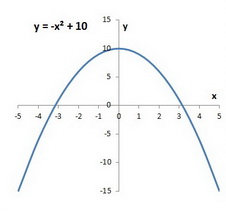How do find the vertex and axis of symmetry, and intercepts for a quadratic equation #f(x) = -x^2 + 10#?
2 Answers
The vertex is at the point
The axis of symmetry is the
Explanation:
Let's look at the function
A function
A function
Recall that
graph{x^2 [-40, 40, -20, 20]}
Recall the coordinates for
So,
If we were to add in more points of interest we'd eventually draw our graph of
Such as
(our function is the curve drawn on the graph above)
...and so on with other values for
When our function is
any value we put in for
This just means that when we plug in a value for
So, for all values of
graph{-x^2 [-40, 40, -20, 20]}
Lastly, if we were to add
this means that our curve's "butt" gets moved up the y-axis by
Recall the slope-intercept form:
where,
we have our
and
graph{-x^2+10 [-40, 40, -20, 20]}
Now, I've been saying "butt" of the function, but that "butt" is our vertex of our function
So, the vertex is at
The vertex is at (
The axis of symmetry is
The
The
Explanation:
Your equation is
The standard form of the equation for a parabola is
So
Let's put your equation into "vertex form".
The vertex form of a parabola is
So
Vertex
Since
The vertex is at (
So the vertex is at (
Axis of symmetry
The axis of symmetry is
Set
The
Set
The



